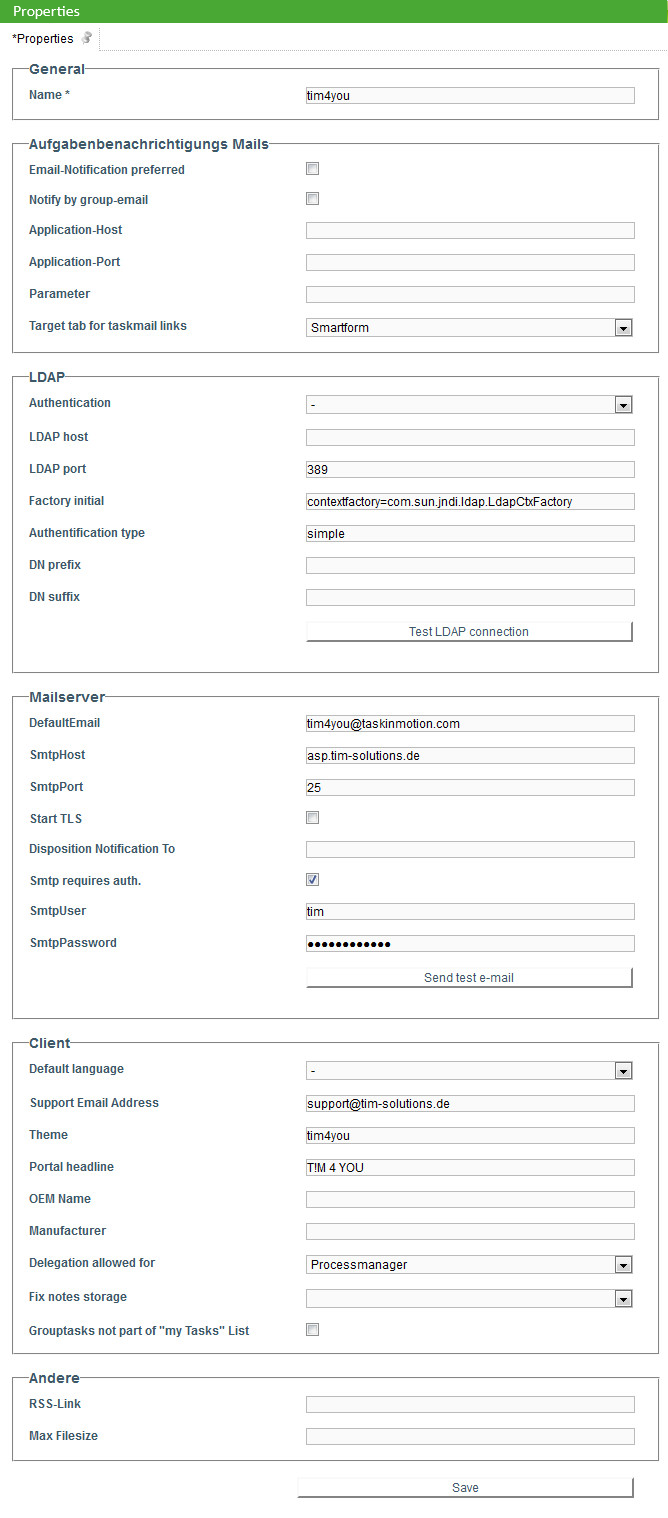Table of Contents
Properties
The client profil can be accessed in the Administrator Client
General
| Field | Description |
|---|---|
| Name | The name of the client is entered in this field. |
Licensing
| Field | Description |
|---|---|
| License key | Here, a license key, which sets the maximum number of users and processes, can be entered. However, as this is normally done via license data in the TIM Engine, it is often unnecessary and empty. |
| Max. Users | In this field, the maximum number of users to be compiled in the corresponding client can be determined. |
| Max. Processes | Here, the maximum number of processes to be deployed can be entered. |
Task Notification E-mails
TIM - Task !n Motion uses the followig parameters to compose the Taskmails, which are sent to the employees. Also, the ${baseLink} is composed from these parameters.
| Field | Description |
|---|---|
| E-mail notification preference | In order to activate the TIM-Taskmails for all users, the Checkbox must be activated. |
| Application-Host | Here, the host name of the server on which TIM was installed is displayed. |
| Application-Port | Here, the port of the server on which TIM was installed is entered. |
| Parameter | This field should only be adapted, if necessary, by a TIM employee. |
| Target tab of task mail links | Here, the user can state which tab should be opened when a user has clicked on the link in a task mail. This setting applies to all users who were recently compiled. |
LDAP
In this area the LDAP interface to TIM can be set up. Further information is available on this Page.
| Field | Description |
|---|---|
| Authentication | Here, an authentication interface is specified. If this field is empty, the TIM- databank is used automatically. In order to establish a LDAP-Authentication, the parameter „ldap“ has to be entered. |
| LDAP-Host | If an LDAP-interface is used, the host name (the IP-address) of the LDAP-server has to be entered here. |
| LDAP-Port | If an LDAP-interface is desired, the port of the LDAP-server has to be entered here (Standard is :389). |
| Factory Initial | The parameter entered here is needed for the initialization of the LDAP-interface and must match the following: (com.sun.jndi.ldap.LdapCtxFactory). |
| Kind of Authentication | The kind of data encryption during the transmission of the LDAP-interface has to be entered. The field can contain the parameters “simple” or “digest-md5”. |
| DNS Prefix | Here, a DNS Prefix for the network can be specified, if it is used in the network. In most cases this parameter can stay empty. |
| DNS Suffix | If a DNS-server exists in the network, the DNS Suffix has to be entered here. The parameter entered here is supplied by the network's IT. |
| Test the LDAP connection (button) | By clicking on this button, the accuracy of the LDAP-connectivity can be checked. Further information is available on this page. |
Mail Server
| Field | Description |
|---|---|
| Smtp return address | The e-mail address that is displayed as the sender on the TIM- notification mails is entered in this input field. |
| SmtpHost | Here, the IP or host name of the mail server used has to be entered. |
| SmtpPort | Here, the port that the mail server follows is entered (standard port :25). |
| Start TLS | Activates the TLS encryption to the mail server, if desired or necessary. |
| Absence message to | Returned absence messages can be forwarded to a certain mail box (to be entered here). |
| Smtp erfordert Auth. | Activates the authentication to the mail server if necessary. |
| SmtpUser | Here, the user having the right to send e-mails via the mailserver is entered. |
| SmtpPassword | Specifies the password of the according Smtp user. |
| Test e-mail configuration (button) | By clicking on this button, the dispatching of TIM- notification e-mails can be simulated in order to test their functionality. Further information is available from email_testing |
Client
| Field | Description |
|---|---|
| Support Emailaddress | Changes the display of the support e-mail-address in the information area of all Clients. |
| Theme | In this field, the Theme to be used is displayed. This is the name of the custom file. |
| Producer | not required |
| Delegation allowed for | Here it is possible to determine for which context roles delegation (transfer of task to third parties) is allowed. If “Person in charge” is selected, useres with the right “member” can delegate tasks to their group's´co-workers. |
| Fix notes depot | If here, for example, process instance is chosen, all notes are attached to the process instance and no longer to tasks. If “task” is chosen as the parameter, but a note is attached to the process instance, the note will still be attached to the instance, as TIM does not know to which task of the instance the note should be attached to. |
| Group tasks not in “My tasks” list | Tasks tab either displays “my tasks and tasks of my group” or “my tasks only”. |
